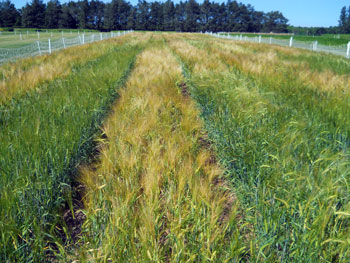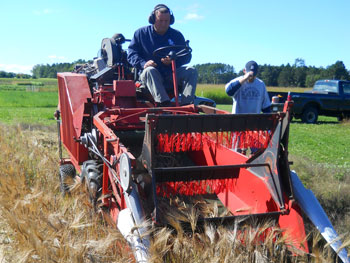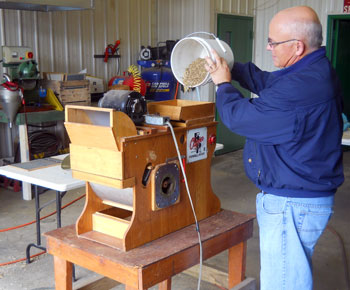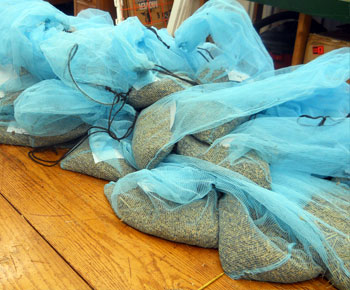Malting barley varieties compared in Michigan’s Upper Peninsula
A Michigan State University Extension research trial tests 19 barley varieties for yield and seed quality.
A malting barley variety trial was developed and conducted at the Michigan State University Upper Peninsula Research and Extension Center (UPREC) in Chatham, Mich., in 2013. The project was funded by a grant from Project GREEEN. The work was performed by UPREC research assistant Christian Kapp and myself. Nineteen barley varieties, including publicly available and privately owned seed lines, were tested. The malting barley variety trial was set up in small plots and was replicated four times to allow for statistical analysis. Michigan State University Extension recommendations were used for determining fertilizer use and weed and disease control measures. Prosaro fungicide was used to reduce the risk of Fusarium head scab.


(Left) Malting barley variety trial plot on Aug. 2, 2013. (Right) Malt barley plot harvest on Sept. 13, 2013.
Partial results are included in the table below.
Yield and test weight corrected to 14.5% moisture
|
Variety |
Type |
Bu/a |
Tst Wt |
|
|
|
14.5% mst |
14.5% mst |
|
Oddyesey |
2-row |
57.21 |
49.8 |
|
NSA 1820 |
2-row |
52.35 |
50.1 |
|
Pinnacle |
2-row |
52.08 |
48.7 |
|
Conrad |
2-row |
49.66 |
49.1 |
|
Genie |
2-row |
49.62 |
50.2 |
|
Merit 57 |
2-row |
48.48 |
47.6 |
|
Overture |
2-row |
48.18 |
49.8 |
|
Voyager |
2-row |
43.1 |
48.4 |
|
Merit |
2-row |
40.93 |
47.8 |
|
Conlon |
2-row |
40.28 |
49.7 |
|
Innovation |
6-row |
55.47 |
47.1 |
|
Lacey |
6-row |
53.98 |
49.5 |
|
Rasmusson |
6-row |
53.65 |
48.5 |
|
Celebration |
6-row |
52.86 |
47 |
|
Tradition |
6-row |
51.89 |
47.4 |
|
Stellar-ND |
6-row |
51.77 |
46.6 |
|
Quest |
6-row |
50.61 |
47.8 |
|
Robust |
6-row |
51.45 |
47.7 |
|
Legacy |
6-row |
48.07 |
46.9 |
|
Mean |
|
50.03 |
48.4 |
|
CV (%) |
|
16.5 |
1.5 |
|
LSD0.05 |
|
ns |
ns |
Grain quality for malting was measured at North Dakota State University with the following key results.
- Harvest moisture was too high (16-17 percent). This lowers germination rate and causes sprouting.
- DON levels (measure of vomitoxin contamination caused by Fusarium head scab) were acceptable for 15 of the 19 varieties. All varieties with higher than desirable DON levels were 2-row types. (All plots were sprayed with Prosaro fungicide to control head scab.)
- Grain protein levels were generally higher than desirable except for four 2-row types.
- Test weight was generally good and seed plumpness was good for all varieties. (Standard barley test weight is 48 pounds per bushel at 14.5 percent moisture.)


(Left) Cleaning and processing malt barley samples on Sept. 16, 2013. (Right) Malt barley samples from combine on Sept. 16, 2013.
Conclusions:
- Yield and test weight of all varieties was close to normal, local averages. There were no statistical differences at the 0.05 level of significance.
- DON levels were generally acceptable, or very nearly so, with the exception of Voyager.
- Protein levels for composite samples were generally too high. Nitrogen fertilizer adjustment could contribute to a solution for this problem.
- Seed moisture, germination and sprouting were generally unacceptable. Grain was harvested at too high moisture content. Late planting and very cool mid-summer and harvest conditions probably contributed to this. Earlier planting, more timely harvest and post-harvest aeration could help correct these problems.
- Additional MSU work with malting barley is needed. A more comprehensive malting barley research proposal has been submitted by the Michigan Brewer’s Guild to MDARD for the 2014 Strategic Growth Initiative Grant Program. The proposal has strong partners, including the Michigan Brewer’s Guild, MSU AgBioResearch and MSU Extension. It includes expanded variety testing in the Upper Peninsula, northwest and northeast Lower Michigan, the Thumb area of Michigan and the Gratiot/Isabella county area. It also includes a component to develop malting and brewing testing facilities for local malting barley destined for Michigan craft brewers, and an educational component to share project results with farmers, maltsters and craft brewers.
A complete report can be viewed online at “Upper Peninsula malting barley variety trial” or contact Jim Isleib at 906-387-2530 for a mailed copy.



 Print
Print Email
Email


